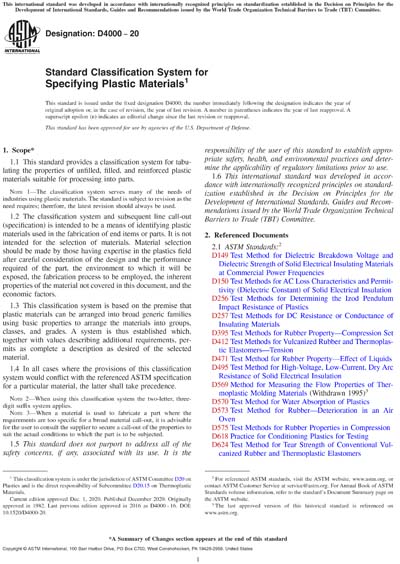Historical
ASTM D4000-20
Standard Classification System for Specifying Plastic Materials
1.1 This standard provides a classification system for tabulating the properties of unfilled, filled, and reinforced plastic materials suitable for processing into parts.
Note 1: The classification system serves many of the needs of industries using plastic materials. The standard is subject to revision as the need requires; therefore, the latest revision should always be used.
1.2 The classification system and subsequent line call-out (specification) is intended to be a means of identifying plastic materials used in the fabrication of end items or parts. It is not intended for the selection of materials. Material selection should be made by those having expertise in the plastics field after careful consideration of the design and the performance required of the part, the environment to which it will be exposed, the fabrication process to be employed, the inherent properties of the material not covered in this document, and the economic factors.
1.3 This classification system is based on the premise that plastic materials can be arranged into broad generic families using basic properties to arrange the materials into groups, classes, and grades. A system is thus established which, together with values describing additional requirements, permits as complete a description as desired of the selected material.
1.4 In all cases where the provisions of this classification system would conflict with the referenced ASTM specification for a particular material, the latter shall take precedence.
Note 2: When using this classification system the two-letter, three-digit suffix system applies.
Note 3: When a material is used to fabricate a part where the requirements are too specific for a broad material call-out, it is advisable for the user to consult the supplier to secure a call-out of the properties to suit the actual conditions to which the part is to be subjected.
1.5 This standard does not purport to address all of the safety concerns, if any, associated with its use. It is the responsibility of the user of this standard to establish appropriate safety, health, and environmental practices and determine the applicability of regulatory limitations prior to use.
1.6 This international standard was developed in accordance with internationally recognized principles on standardization established in the Decision on Principles for the Development of International Standards, Guides and Recommendations issued by the World Trade Organization Technical Barriers to Trade (TBT) Committee.
Content Provider
ASTM International [astm]






